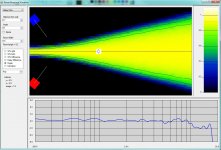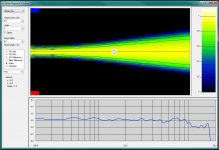Markus
I simply do not understand your point of view.
There's nothing to understand. I simply reported my observation and you reported yours. The difference is that I accept yours but you don't seem to accept mine.
Just ran another test with headphones. Female voice, right channel 1ms earlier. It takes about 15dB level difference between channels to move the auditory event back to the center. But even then the sensation is "something's wrong".
There's nothing to understand. I simply reported my observation and you reported yours. The difference is that I accept yours but you don't seem to accept mine.
Just ran another test with headphones. Female voice, right channel 1ms earlier. It takes about 15dB level difference between channels to move the auditory event back to the center. But even then the sensation is "something's wrong".
You can't do this perfectly, at least not without ideal radiation patterns, which may or may not be possible. All you can do is optimize the speakers you have by toeing them in to the best possible location.
At the minimum, you should at least optimize toe-in so simple head movement in the seated position doesn't cause ANY image position changes. After that, a wider and wider sweet spot without compromising tonality in the center seat. With a given set of speakers, you might find that the image moves along with you when moving left or right, or stretching horizontally, without snapping to the nearest speakers. Off axis FR will effect just how much you can do to widen the sweet spot without affecting the image/tonality in the center seat.
Last edited:
I had set them up with the 0° axis pointing to the listening position.
Generally, I find it works better if the zero axes cross a foot or two in front of the listening position, which is what happens if you aim each speaker to it's opposite farthest seating position. Optimum toe-in usually falls between that extreme toe-in and toe-in aimed directly at the center listener position.
Last edited:
What can this study do for the individual stereo listener. For example, the quality of the reverberant field?
No reverberant field - just the direct field. Not even early reflections as yet. The idea is to learn about how different loudspeakers polar responses arrive at the listener in different setup conditions like separation and toe-in.
Last edited:
The difference is that I accept yours but you don't seem to accept mine.
I accept yours, but I think that we might be looking for different things. What I am looking for I can achieve, but I want to know the parameters and the range of those parameters that maintains the goal. I get questions on this all the time and now I have a program that can be used by the end user in the field to determine the situation for themselves.
That it doesn't work for you is really not an issue. It's too bad that it doesn't, but that happens.
Generally, I find it works better if the zero axes cross a foot or two in front of the listening position, which is what happens if you aim each speaker to it's opposite farthest seating position. Optimum toe-in usually falls between that extreme toe-in and toe-in aimed directly at the center listener position.
That is all very dependent on the speakers and the response off axis. I suggest a toe-in a little greater than what you are suggesting, but my speakers can get away with it. In fact they have the smoothest response at the listening position when this is done.
That is all very dependent on the speakers and the response off axis. I suggest a toe-in a little greater than what you are suggesting, but my speakers can get away with it. In fact they have the smoothest response at the listening position when this is done.
Yes, very speaker dependent. That's why most of what I've been saying is how to find the proper toe-in for a given speaker. Off-axis FR is key.
A further listening test, after side-to-side lean at the center seat to test and adjust toe-in for minimal image shift, is to lean forward to the point where the axes cross, and back to normal seating position, to detect any tonality changes. The toe-in should then be altered, if necessary, for the best compromise between tonality and widest sweet spot for imaging at the seated position. Hopefully they will have the same toe-in for both, but if not, then adjust to taste, as long as there is no known perfect loudspeaker with optimum FR and radiation pattern.
Last edited:
Here is an interesting comparison. The Abbeys can be pointed straight ahead and achieve the same frequecny response as toe-in, but with a much smaller field of good imaging. The non-toe-in would have strong early reflections and an enhanced spaciousness, but a degraded image. But you can have it either way if you want. Or put them on a turntable!
These plots have much higher grid resolution. It was only a minor hit to the real time updating. The gradient algorithm still has trouble with a very steep gradient.
These plots have much higher grid resolution. It was only a minor hit to the real time updating. The gradient algorithm still has trouble with a very steep gradient.
Attachments
Rather unfortunate that the effect isn't the same for all. I seem to be in a fortunate situation in that thetoe-in works very well for me. In fact my usual seat is almost directly in front of the right speaker with hardly any image shift when I move to center (this using 90 degree conical waveguides).
Marcus, have you had others listen to your setup to see if the trading works for them? Wondering whether it's the listener or something to do with the room acoustics instead?
I have a reviewer friend who has a "tweak" doo-dad thing that is like a tall stand that holds a small brass dish. It sits between the speakers, about where a center image might be expected to be. I wonder if it's really just acting as a target to focus attention there and encourage image centering?
Marcus, have you had others listen to your setup to see if the trading works for them? Wondering whether it's the listener or something to do with the room acoustics instead?
I have a reviewer friend who has a "tweak" doo-dad thing that is like a tall stand that holds a small brass dish. It sits between the speakers, about where a center image might be expected to be. I wonder if it's really just acting as a target to focus attention there and encourage image centering?
No reverberant field - just the direct field. Not even early reflections as yet. The idea is to learn about how different loudspeakers polar responses arrive at the listener in different setup conditions like separation and toe-in.
Ok. This is to increase the volume of the room that will image.
...I was seeing it as increasing the power that is involved in good imaging, because it will affect the reverberant field later. As the two point sources intersect and the waves diffract with each other, they'll dilute the field with a L+R signal. This might make diffusion and/or strong rear reflections less critical.
With only one clean L+R diffraction mode to exploit, it seemed easier than making the room perfectly symmetrical, even if that would help 😕.
Anyway, just thought your utility would show the same needed information.
correctOk. This is to increase the volume of the room that will image.
Anyway, just thought your utility would show the same needed information.
?😕 "the same needed information"?
Yes, the way to maximise (before a reflection) the two speaker's interaction 'showing their best side', in order to reduce reverberation capable of identifying either of the speakers?
Maybe this is cheating. When i want a wider sweet spot for a center image, i put a derived mono center speaker between the L-R speakers. nails that center image. Just make it slightly lower in magnitude/level than left-right so as to not be obnotiously obvious.
Etc.
Then directivity of the L-R speakers is best used to minimise side wall reflections and/or place L-R on the wide side of the rectangular room well away from walls.
With the third channel or derived center mono speaker and using CD speakers.... its the best of all possible worlds. Highly focused, precise imaging and smooth response at the listener.
Etc.
Thx-RNMarsh
Etc.
Then directivity of the L-R speakers is best used to minimise side wall reflections and/or place L-R on the wide side of the rectangular room well away from walls.
With the third channel or derived center mono speaker and using CD speakers.... its the best of all possible worlds. Highly focused, precise imaging and smooth response at the listener.
Etc.
Thx-RNMarsh
Last edited:
Theres a wealth of information regarding this topic on the site in general - it is pretty large, and well known in germany.
My take on the topic: In your usual listening room you level difference resulting from listeners distance towards each respective channel is pretty much a non-factor, unless you're really close or the room is made really dead. Time difference is much more relevant. Which of course doesn't change if you merely toe in your speakers.
Now I'm not all that knowledgable about a lot of speakers' polar plots, but level drops a lot if you go past some ~15°+ off axis right, higher frequency - sharper drop. Naturally you will get better coverage of a speaker's "good area" if you toe them in - instead of aiming their 0° right at the back wall ... so I think it all essentially boils down to how much beaming does your speaker show in the relevant upper mids/highs, doesn't it?
My take on the topic: In your usual listening room you level difference resulting from listeners distance towards each respective channel is pretty much a non-factor, unless you're really close or the room is made really dead. Time difference is much more relevant. Which of course doesn't change if you merely toe in your speakers.
Now I'm not all that knowledgable about a lot of speakers' polar plots, but level drops a lot if you go past some ~15°+ off axis right, higher frequency - sharper drop. Naturally you will get better coverage of a speaker's "good area" if you toe them in - instead of aiming their 0° right at the back wall ... so I think it all essentially boils down to how much beaming does your speaker show in the relevant upper mids/highs, doesn't it?
Last edited:
This is "equivalence" not "trading". Please don't confuse both terms.
i put a derived mono center speaker between the L-R speakers.
A more sophisticated way to do this is to use a matrix decoder, e.g. AcourateConvolver - AudioVero
This is "equivalence" not "trading". Please don't confuse both terms.
Agreed. The equations have to be a function of both the time difference and the level difference. The site uses the two independently and this will not yield any "trading". But since none of it works anyways, it doesn't matter.🙂
Yes, the way to maximise (before a reflection) the two speaker's interaction 'showing their best side', in order to reduce reverberation capable of identifying either of the speakers?
I still don't understand the question. 😕
Agreed. The equations have to be a function of both the time difference and the level difference. The site uses the two independently and this will not yield any "trading". But since none of it works anyways, it doesn't matter.🙂
It does matter, just not in this context 😛
- Status
- Not open for further replies.
- Home
- Loudspeakers
- Multi-Way
- New study on loudspeaker placement

